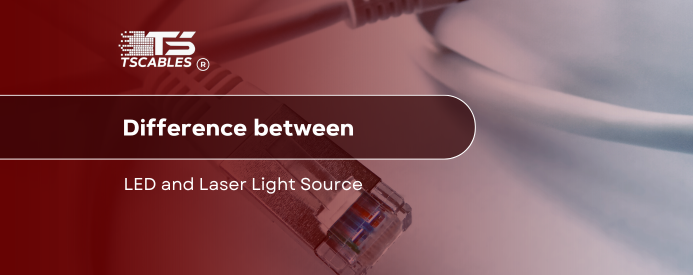Light serves many roles, from brightening rooms to powering communication lines. LEDs glow softly and spread light widely. Lasers produce narrow, intense beams. You might have used party lights and lasers or seen laser lights for room setups.
Understanding laser vs LED light helps pick the right option. Both play crucial parts in electronics, broadband, and displays. Their differences lie in brightness, cost, structure, and function.
This article explains those differences simply. After reading, you’ll know when to use laser light or optical fiber LED and why some devices are lamped with LED while others beam with laser. Let’s start by understanding the key difference between laser and LED,
Laser vs LED: Brief Overview
LED stands for light-emitting diode. Electricity excites a chip to glow across a wide area. Lasers, in contrast, use amplified light bouncing inside mirrors or crystals, forming a focused beam. While both emit light, they do so differently. Simply put, LEDs spread light whereas lasers keep it tight.
Those differences shape usage. LEDs light candles, bulbs, and screens. Laser beams cut steel, send data across fiber, or dazzle crowds. Now let’s dig deeper into LED vs laser differences and learn when each wins.
Key Differences Between Laser vs LED
LED and laser technologies have distinct strengths. Their performance differs in speed, distance, cost, structure, and lifespan. These traits matter for your application. Your choice affects range, clarity, price, energy, and maintenance. Let’s examine each area by diving into speed, reach, rate, design, and durability.
Difference in Speed
Lasers emit light in one tight wavelength, boosting data-carrying speed. They don’t scatter, so signals stay sharp. LEDs shine across multiple wavelengths and which diffuses the signal and limits speed. Data sent through fiber often uses lasers for fast, precise transfers. LEDs work in lamps or low-speed links, like indoor lighting or small displays.
Transmitting Distance
Lasers hold their beam tight, reaching miles with little loss. That makes them great for long-haul fiber. LEDs spread quickly, weakening across distance. For short indoor lighting or displays, that’s fine. But for telecom or optical fiber led, lasers preserve strength and clarity over kilometers.
Cost
LED gear costs less as production scales keep prices friendly. Laser parts use mirrors and precise cavities. That pushes the cost up. For home lamps or simple gear, LEDs fit the bill. High-speed telecom or laser lights for the room may justify the laser’s price tag, thanks to speed and reach.
Structure
Inside an LED is a simple chip and a plastic lens. Light scatters outward softly. A laser module uses precise mirrors, gain media, and control chips to produce focused beams. That adds parts and alignment needs. LEDs are easy to build and long-lasting. Lasers require exact assembly and heat controls.
Durability
LEDs are solid-state and rugged. They handle bumps and moisture well. Lasers need tighter control of heat and cleanliness. A dusty mirror can reduce laser lifespan. LEDs outlast lasers in rough environments. Still, both can run for thousands of hours if cared for properly.
Practical Uses of LEDs and Lasers
LEDs and lasers shine in very different applications. If you think about how they serve people every day, their strengths stand out. Below are five areas where one option clearly fits better than the other, depending on your need:
- Lighting household rooms and offices
- Laser pointers and precision measurement tools
- LED-based home or display signage
- Laser in fiber-optic telecom systems
- LED safety lights and emergency indicators
Energy Efficiency Along with Human and Environmental Impact
LEDs are famous for energy efficiency. They use less power and stay cool. Lasers convert electricity into intense beams. That sometimes wastes more energy as heat. For large lighting projects, LEDs save on power bills.
For telecom or data links, lasers deliver power where it's needed, despite higher energy consumption. Still, modern diode lasers have improved efficiency.
Both types require safe handling. LEDs emit safe light for humans. Lasers, especially strong ones, can harm eyes or skin if misused.
Environmental footprint also matters. LEDs use fewer rare metals and last longer. Lasers need more parts and careful production. Disposal and recycling differ, too. Always follow local guidelines when disposing of high-powered laser modules.
Takeaway
Lasers and LEDs serve very different roles. LEDs light up our homes safely and affordably. Lasers move data, show patterns, and power pinpoint tools. Your environment, range needs, and cost decide which to use.
Both remain essential as LED and laser light sources meet different needs. LEDs brighten displays and lighting inexpensively. Lasers enable fast telecom, cutting tools, and precise beams. The right choice depends on your setup. TS Cables offers quality cables and modules for both LED and laser systems.
FAQs
Can LEDs create the same beam effect as lasers?
LEDs mimic laser effects with patterns, but can’t match focus or long-distance clarity.
Are laser lights for the room safe for kids?
Low-power models are safe, but always keep beams away from your eyes to avoid accidental harm.
Do lasers use more power than LEDs?
Yes. Lasers often need more energy for focused output. LEDs remain more efficient for broad lighting.
Which lasts longer: LED or laser?
LEDs often exceed 50,000 hours. Lasers vary as cooling and alignment affect their lifespan.
Can fiber LEDs replace lasers in telecom?
Fiber LED modules handle short links. Long-distance telecom relies on laser modules for performance.






